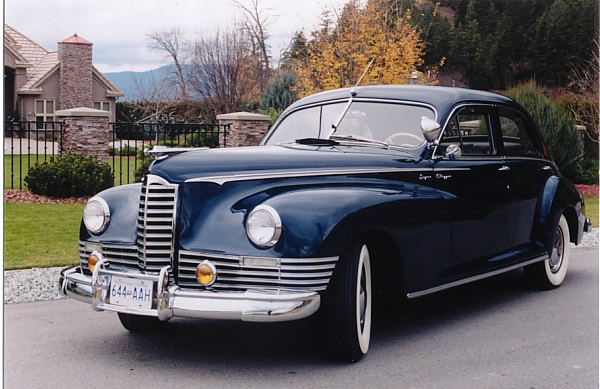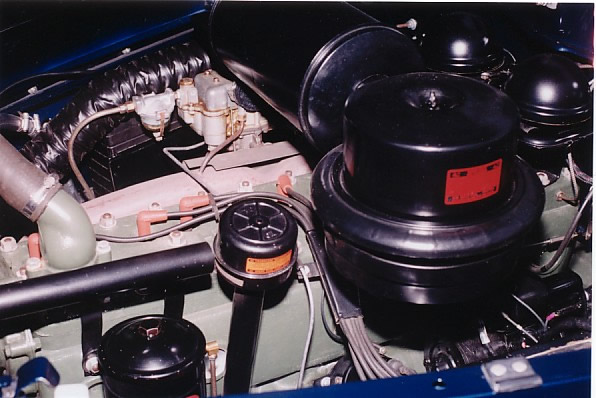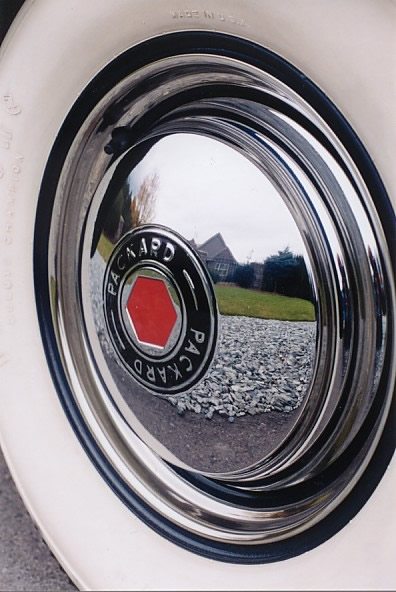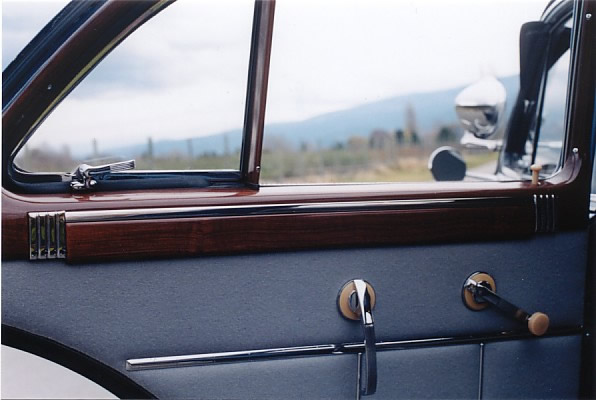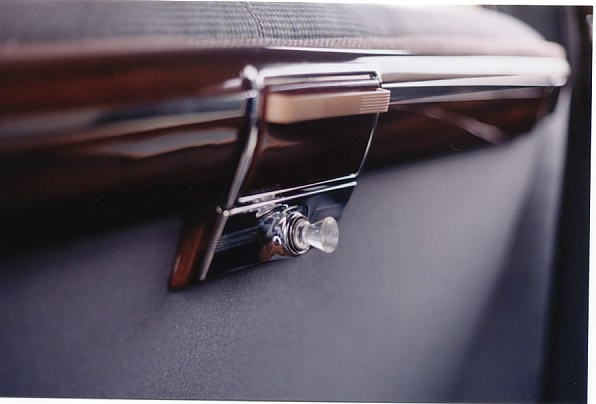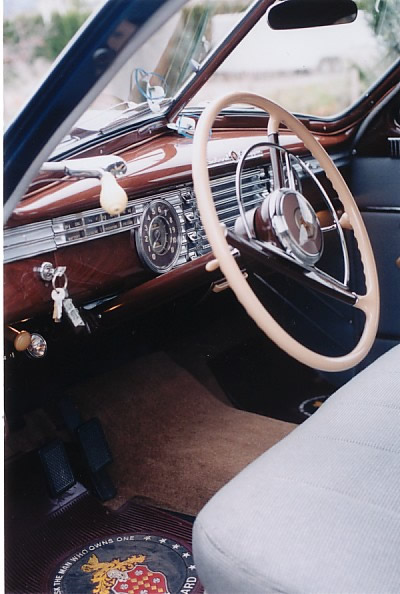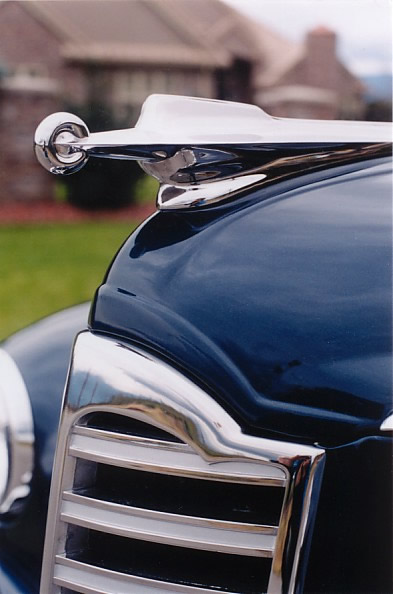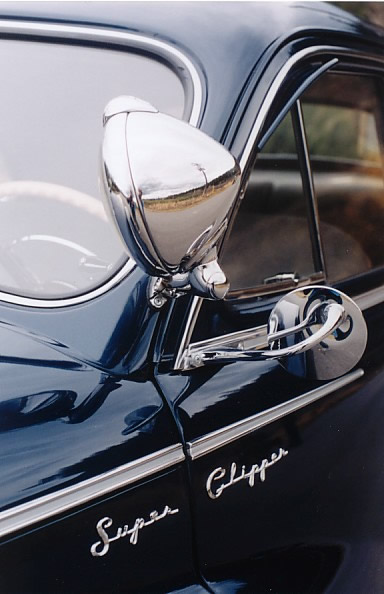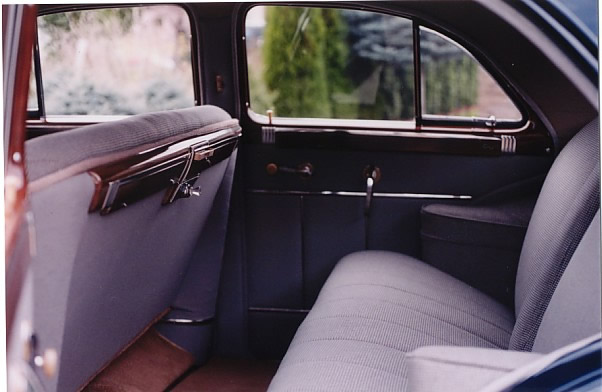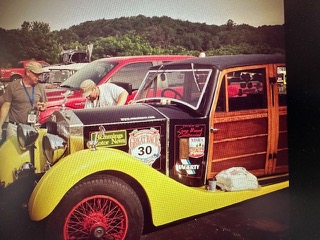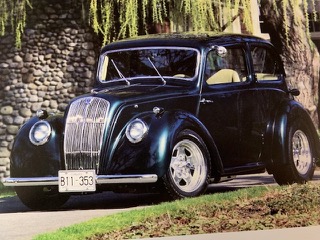Ask the man who owns one
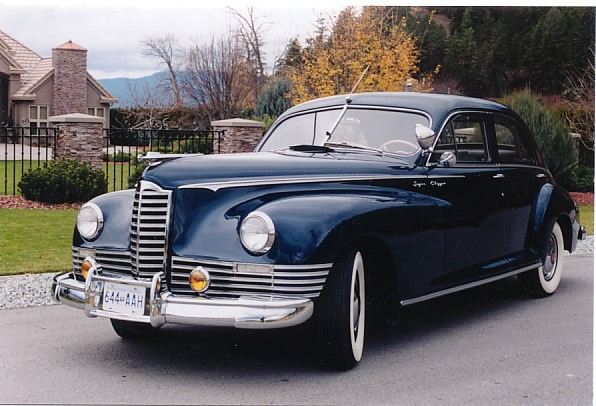 Another ¾ front view of this 1947 Packard Super Clipper. Packard produced 4802 units of this model.
Another ¾ front view of this 1947 Packard Super Clipper. Packard produced 4802 units of this model.In 1941 The Packard Motor Car Company introduced the first of the handsome Clipper Line of cars. A 245.3 cubic inch six cylinder and a 282 cubic inch straight-eight version were produced. These cars were designed by “Dutch” Darrin and modified by Packard stylist Werner Gubitz. The Clipper was the first major departure from the traditional square-box styling used in previous models. The flowing fenders, hidden running boards, tapered rear end and narrow vertical grille, all came together, and resulted in the most stylish models the company had yet produced in its’ long history. This model came in only one body style, a four-door sedan, priced at $1420. The Clipper model sat squarely between the One Twenty and One Sixty and had a 127 inch wheelbase.
At the low range of models offered by Packard for 1941, were the One Tens and One Twentys, while the Super Eight, which was now the One Sixty, and the Custom Super, which was now called the One Eighty, were the more posh models. As usual Packard offered Darrin, Rollston and LeBaron custom coachwork. The long- wheelbase sedans, limousines and the lovely formal Sport Brougham were built by LeBaron.
Power for the Supers and Customs was provided by the silky smooth 356 cubic inch straight-eight which developed 160 bhp at 3800 rpm. This engine had nine main bearings, a crankshaft that weighed 105 pounds, and was capable of propelling the lighter models at well over 100 mph. An Elecromatic Clutch, which eliminated the need to use the clutch pedal when the driver shifted gears, was offered as an option for $37.50. The Clipper was popular and over 16,000 units sold in 1941.
In 1942, Packard, with the exception of the One Twenty convertible and some One Eighty models, converted their lines almost entirely to Clipper styling.
As other automobile manufacturers had done, Packard joined in with war production in 1942. They built Rolls-Royce Merlin aircraft engines and other power units used in military vehicles and PT boats. It was the only independent car company to emerge from the war completely debt free.
When civilian automobile production resumed, a watershed decision was made that adversely affected the company’s future. Instead of reverting to producing only luxury cars, Packard continued to produce middle-priced models in the One-Twenty tradition. Those cars did sell well before the war, and were necessary, but after World War II these models seriously damaged Packard’s image. Cadillac on the other hand discovered that it could sell anything on wheels, kept LaSalle on the back burner, and built nothing but high priced cars. Soon, it would replace Packard as the Nation’s premiere luxury make.
The 1946-’47 Packard models were identical in all respects except for the serial numbers. The low priced ’46 Clipper Six sedan and coupe looked exactly the same as the Clipper Eight series, which also included a Deluxe Sedan and Club Sedan. All models used the 120 inch wheelbase.
Clipper Supers and Customs – Sedans and Club Sedans rode on the 127 inch wheelbase. The Custom Series also offered a seven-passenger sedan and limousine. These cars rode on the 148 inch wheelbase. The Eights were equipped with the pre-war 282 cubic inch engine, while the Supers and Customs used the 165 bhp 356 cubic inch power plant. Overdrive and the Electromatic clutch were available once again as options. Customs were trimmed with plush broadcloth and leather upholstery. Special carpeting and beautiful imitation wood paneling were used throughout. The dashboards in these years were symmetrical, as they had been before the war. The speedometer was positioned on the left of the steering column, minor gauges were at the far left, the clock was at the right, and the radio and heater controls were located in the center of the dash.
In 1946 Packard sold over 30,000 cars and over 50,000 in 1947.
Ian Whittaker from Westbank, B.C. owns the 1947 Packard Super Clipper which his father Gerry, painstakingly restored.
Ian’s dad passed away in 2000 and Ian approached his mother about wanting to buy the car, and she sold it to him.
Years ago, Gerry Whittaker owned a 1930’s Ford, and although he had the car for quite some time, he did not have the opportunity to restore it. Eventually the car was sold to a man in Alberta. Three years later, a photograph arrived in the mail of his former Ford, which was now completely restored. This photograph inspired Ian’s father to fulfill his dream of restoring a car of his own.
Approximately one year later, one of Gerry’s brothers phoned him with a lead on a car sitting in an old farm garage in Three Hills, Alberta. He told Gerry that he should go down and have a look at it. The elder Whittaker took a trip in May of 1994 to inspect this old Packard, which had been parked there since 1966. A deal was struck and he bought the car.
Ian remembers his dad stopping by his place, on his way home with this car, and seeing this “rust bucket of a car” sitting on the car trailer. Gerry saw the vision for this car that his son couldn’t see at the time.
The first thing his dad did with the Packard when he got it home, was to get the engine running. From there it was a 3 ½ year full-time endeavour to restore this vehicle into a pristine example of this model.
Gerry’s daily routine consisted of getting up each day to work on the Packard. Many phone calls were made and letters written with requests for the many parts that were required to assemble this car. The internet was available at this time and would have made the job of searching for parts a little easier, but unfortunately, he wasn’t connected to it.
Ian’s father was very meticulous and thorough in his restoration work, and once committed to the task at hand, he stayed the course. Each task was thoughtfully weighed, and he took the trials and tribulations encountered in stride, pursuing those elusive parts with undaunted perseverance, until he was successful in procuring them. He installed them with the precision of the master craftsman he was.
Once the job was finally completed, Gerry enjoyed the Parkard for 2 ½ years, racking up a total of 2000 miles on the restored car. He took it to several car shows. The longest trip he made in the car was from Valleyview, Alberta to Radium Hot Springs, B.C. Whittaker was always careful not to expose the car to inclement weather, and for the most part, stayed off the main highways.
Gerry had intended to sell the Packard to the Reynolds Museum in Wataskiwin, Alberta. Two weeks before he died, three gentlemen from the museum were planning to come up to look at the car, but because of heavy rain, they postponed
their trip. Ian’s father then became gravely ill with bone cancer, and as a result the Reynolds Museum people were unable to meet with Gerry.
“I knew dad was talking with these people,” recounted Ian, “and about three days before he passed away,” he continued, “I phoned him up and said that Nancy and I would like to buy the car from him. We don’t want the Packard to go to a museum and want to keep the car in the family.” His father replied, “well, I will have to think about it.” That was the last time Ian talked with his dad about the car.
It was after Gerry passed away that Ian was able to make a deal to buy the car from his mother . . . and that is how the car stayed in the family! “I don’t have any intentions of this car going anywhere,” Ian emphasizes. The Packard is a permanent and tangible lasting legacy from his dad.
“My dad spent the final years of his life rebuilding this car,” says Ian. “This was his life, and to see this car as it stands today,” he continued reflectively, “there are a lot of memories there.”
Since Ian and his wife Nancy have owned this car, the Packard Super Clipper is taken out of the garage on a nice day, cleaned and then taken for a leisurely drive with the family around the South Okanagan area.
The car was entered in the Field of Dreams Car show in Kelowna, B.C. on September 8th, 2001. This event featured almost a thousand vintage cars and trucks, mostly from the Okanagan region. Ian discovered, to his pleasant surprise, that there was a lot of keen interest in the car from vintage car enthusiasts as well as from the general public that attended the event.
“The Packard makes you step back in time,” observes Ian. “When our two young girls come along and sit in the large back seat . . . and there are no seat belts, in today’s world, for them,” he continues, “that’s unbelievable!”
Because the car draws a lot of attention, Ian enjoys listening to seasoned hobbyists as they talk about the old Packards. “Myself, I didn’t know much about them,” Whittaker admits, “even while my dad was doing the restoration. When you go to car shows, where there is a lot of interest in an old car like this,” continues Ian, “that are in a condition, as if it just drove out of the factory yesterday!”
Yours truly had the rare opportunity to ride in this magnificent automobile, and like those other auto enthusiasts, I was impressed with the quality of workmanship in this car. The broadcloth upholstery, the comfy chesterfield-like seats, the simulated walnut trim adorning the window frames and dashboard, was most amazing to me, in this age of bland plastic trimmed cars. The straight-eight is whisper quiet, hardly perceptible when it is running. There are many newer
cars that couldn’t purr as quietly as this Packard. One thing you have to get used to when you are driving this car is the lack of synchromesh when shifting into first gear with the three-speed column shift transmission. This was typical though, for cars of this era, and even a lot newer. The ride in this luxury car is sumptuous, to say the least, and there is that unmistakable “aura of elegance” you sense, as you cruise past people out for their daily walk or jog, pausing to notice this piece of mobile nostalgia going by.
Besides personal use, Ian sees the car being engaged in the future as a wedding car for his niece next summer, and he is open for requests on special occasions, functions, parades, etc., that the use of an old vehicle would be appropriate for. “I’d like to show it off,” he admits, “to show people that there were some pretty magnificent cars back then, and that some of them still exist.”
The 1947 Packard Super Clipper is the entry-level car for Ian, who also has a keen interest in hot rods, etc. “Whether I would do a restoration like this,” says Whittaker with trepidation, “I don’t know. It was a very big and painstaking ordeal for my dad,” he continues. “One needs the stamina to see it from beginning to end, and that person would have to possess a pretty clear picture in their mind to carry the project right through to the finish.”
So what are Ian’s plans for his future in the old car hobby? He just enjoys getting out to meet the people, and talk about the myriad of interests in this newly adopted pastime, from vintage cars to hot rods, and just having fun.
Sooo . . .what is it like to drive a Packard? “Ask the man who owns one”, Ian will tell you.
| 2100 Clipper Six (wb 120.0) | 14,949 Built | Weight | Price | Production |
|---|---|---|---|---|
| 2182 | 4 door Sedan | 3,520 | 1,937 | —— |
| 2185 | Club Sedan | 3,475 | 1,912 | ——- |
| 2111 Clipper Deluxe Eight (wb 120.0) |
23,855 Built | Weight | Price | Production |
| 2112 | 4 door Sedan | 3,695 | 2,149 | ———- |
| 2115 | Club Sedan | 3,475 | 2,124 | ———- |
| 2103 Super Clipper (wb 127.0) |
4,802 Built | Weight | Price | Production |
| 2172 | 4 door Sedan | 4,025 | 2,772 | ———- |
| 2175 | Club Sedan | 3,980 | 2,747 | ———- |
| 2106 Custom Super Clipper (wb 127.0) |
7,480 Built (includes 148.0 wb) |
Weight | Price | Production |
| 2122 | 4 door Sedan | 4,090 | 3,449 | ———– |
| 2125 | Club Sedan | 3,384 | 2,125 | ———– |
| 2126 Custom Super Clipper (wb 148.0) |
Weight | Price | Production | |
| 2150 | Limo 7P | 4,920 | 4,668 | ———— |
| 2151 | 4 door Sedan, 7P |
4,890 | 4,504 | ———— |
